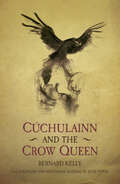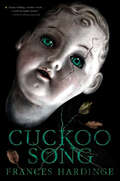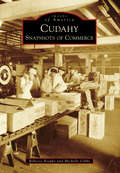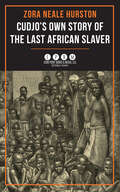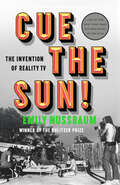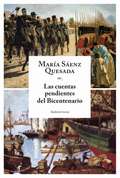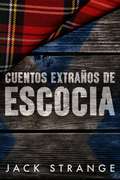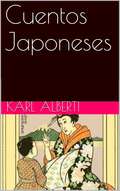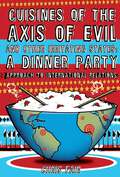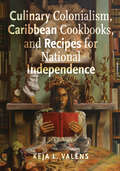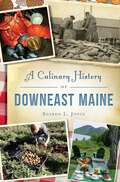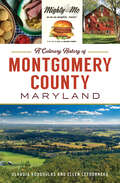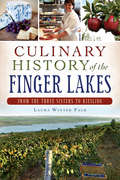- Table View
- List View
Cuchulainn and the Crow Queen: Ancient Legends Retold
by Bernard Kelly June PetersThere was a time in Ireland's history when chivalry and chieftainry ruled the land. When the country was occupied by bands of warriors who spoke only their native tongue and who cherished their heritage and civilisation. This was the time of Cuchulainn. All of the warrior bands had their own Seanachie, a person responsible for recounting the deeds of times past, a chronicler of the ages. Cuchulainn was their most famous subject and hundreds of tales of his heroic and terrifying deeds, such as single-handedly defending Ulster at the age of seventeen, and his battle frenzy in which he knows neither ally nor enemy, have survived to this day. This is an exhilarating new telling of Cuchulainn for our time, full of valour, passion and bloodshed.
Cuckold Point
by Patrick EasterOctober, 1799. A century is coming to an end, but river policeman Tom Pascoe's work is never done. A new case in London's Docks holds danger not just for Tom but for the nation. Sailing master Robert Cox cannot pay his gambling debts. But he has information about a ship which has arrived in British waters carrying a precious cargo. Selling that information to one of London's most feared men might be Robert Cox's salvation - or his damnation. Elsewhere in the warren of streets and waterways, Tom and his assistant Sam Hart are tipped off about a robbery. Their inquiries take them to London's secretive Jewish community, where a dealer admits to being told that a quantity of silk is about to come on the market. When Robert Cox goes missing and powerful men from London's underworld and beyond begin to hunt for the silk, Tom finds himself investigating not just a crime but a conspiracy that will threaten his life, his family and his country.
Cuckoo Song
by Frances HardingeFollowing a mysterious accident that leaves her sopping wet, Triss awakens to a world that’s eerily off-kilter. Her memories are muddled, her sister despises her, and when she brushes her hair, out come crumbled fragments of leaves. Is she going mad? Or did her accident trigger a nightmarish chain of events? In her quest to learn the truth, Triss ventures from the shelter of her parents’ protective wings into the city’s underbelly. There she encounters strange creatures whose grand schemes could forever alter the fates of her family. From master storyteller Frances Hardinge comes the unnerving tale of one girl’s struggle to confront her darkest fears in order to triumph over a world where nothing is as it seems.
Cucumber Man: (Henry Pratt) (Henry Pratt #1)
by David NobbsIt is 1957. The Suez Crisis has been and gone. Henry Pratt has completed his National Service and is putting his unsuccessful career as Thurmarsh's cub journalist behind him. Leaving Yorkshire, he's taking on a new role and a new challenge - working for the Cucumber Marketing Board in Leeds.Stumbling through the fifties, sixties, seventies and eighties, Henry Pratt accumulates jobs, marriages and children on the way as he embarks on a touching, painful and hilarious switchback ride through a divided Britain.
Cudahy: Snapshots of Commerce (Images of America)
by Michelle Gibbs Rebecca RoepkeCudahy's commerce began with Patrick Cudahy, an Irish immigrant who started a meatpacking business in 1892. He invited other industrialists to follow him to the farmlands southeast of Milwaukee, and soon nationally known companies like Ladish, Federal Rubber, and George Meyer opened factories in the new city. Smaller businesses like Adamczyk's Meat Market, Dretzka's Department Store, Pinter's Inn, and Sullivan's Cigar Shop thrived amidst a growing population. With the gradual loss of heavy industry after World War II and the rise of retail box stores, Cudahy has strived to attract commercial and light manufacturing companies like the Gift Shoppe, Milwaukee Cylinder, National Tissue, and Angelic Bakehouse. Cudahy started as--and continues to be--a small town with big opportunities.
Cudjo's Own Story of the Last African Slaver
by Zora Neale HurstonOriginally published in The Journal of Negro History, this fascinating and important work records the recollections of Cudjo Lewis, one of the last surviving captives of the Clotilde, the final ship to dock in the United States with a cargo of African slaves. Lewis and Zora Neale Hurston provide an ethnography of Lewis's own Togo people, detail his capture by warriors of the Kingdom of Dahomey, hardship and strife aboard the Clotilde en route to port in Alabama and his eventual liberation.
Cue Tears: On the Act of Crying
by Daniel SackCrying holds a privileged place in conversations around emotions as an expression of authentic feeling. And yet, tears are ambiguous: they might signal the most positive and negative of affects; they might present a sincere revelation of self or be simulated to manipulate others. Unsurprisingly, tears figure prominently on stage and on screen, where actors have experimented with the mechanics of making tears. Cue Tears: On the Act of Crying uses tears as a prism through which to see some of the foundational problems and paradoxes of acting and spectatorship anew, including matters of authenticity and sincerity, the ethics of the witness, the interaction between a speech act and its affective force, liveness and documentation. Across seven semi-autonomous essays, Cue Tears looks at the mechanisms of tear production, internal and external techniques that actors use to weep, and the effects of tears in performance situations on the stage, in the gallery, and in the classroom. The writing moves with a light touch between theory and criticism of a broad range of instances from literature, theater, performance art, visual art, and cinema, while also embracing a strong autobiographical and personal slant. Author Daniel Sack’s father was a biochemist who studied tears and collected his son’s tears for research during his childhood. These “reflex tears” were produced as a physical response to irritation—an eye stretched past the point of blinking, a cotton swab up the nose. This childhood occupation coincided with his first years taking acting classes, trying to learn how to cry “emotional tears” onstage through psychological stimulation and the recollection of memory. Cue Tears investigates these memories and methods, finding that tears both shore up and dissolve distinctions between truth and artifice, emotional and physical, private and public, sad and humorous.
Cue the Sun!: The Invention of Reality TV
by Emily NussbaumThe rollicking saga of reality television, a &“sweeping&” (The Washington Post) cultural history of America&’s most influential, most divisive artistic phenomenon, from the Pulitzer Prize–winning New Yorker writer—&“a must-read for anyone interested in television or popular culture&” (NPR) &“Passionate, exquisitely told . . . With muscular prose and an exacting eye for detail . . . [Nussbaum] knits her talents for sharp analysis and telling reportage well.&”—The New York Times (Editors&’ Choice)In development as a docuseries from the studio behind Spencer and SpotlightONE OF THE CHICAGO TRIBUNE AND THE CHICAGO PUBLIC LIBRARY&’S TEN BEST BOOKS OF THE YEAR A BEST BOOK OF THE YEAR: The New York Times Book Review, NPR, The New Yorker, Vanity Fair, The Boston GlobeFINALIST FOR THE ANDREW CARNEGIE MEDAL FOR EXCELLENCE IN NONFICTIONWho invented reality television, the world&’s most dangerous pop-culture genre? And why can&’t we look away? In this revelatory, deeply reported account of the rise of &“dirty documentary&”—from its contentious roots in radio to the ascent of Donald Trump—Emily Nussbaum unearths the origin story of the genre that ate the world, as told through the lively voices of the people who built it. At once gimlet-eyed and empathetic, Cue the Sun! explores the morally charged, funny, and sometimes tragic consequences of the hunt for something real inside something fake.In sharp, absorbing prose, Nussbaum traces the jagged fuses of experimentation that exploded with Survivor at the turn of the millennium. She introduces the genre&’s trickster pioneers, from the icy Allen Funt to the shambolic Chuck Barris; Cops auteur John Langley; cynical Bachelor ringmaster Mike Fleiss; and Jon Murray and Mary-Ellis Bunim, the visionaries behind The Real World—along with dozens of stars from An American Family, The Real World, Big Brother, Survivor, and The Bachelor. We learn about the tools of the trade—like the Frankenbite, a deceptive editor&’s best friend—and ugly tales of exploitation. But Cue the Sun! also celebrates reality&’s peculiar power: a jolt of emotion that could never have come from a script.What happened to the first reality stars, the Louds—and why won&’t they speak to the couple who filmed them? Which serial killer won on The Dating Game? Nussbaum explores reality TV as a strike-breaker, the queer roots of Bravo, the dark truth behind The Apprentice, and more. A shrewd observer who adores television, Nussbaum is the ideal voice for the first substantive history of the genre that, for better or worse, made America what it is today.
Cuenta a las abejas que me fui (Saga Outlander #Volumen 9)
by Diana GabaldonTras siete largos años de espera, llega la nueva entrega de la apasionante saga de Diana Gabaldon que ha inspirado la aclamada serie televisiva «Outlander». En 1779, Claire y Jamie se reúnen con su hija Brianna, su marido, Roger, y su familia. Sin embargo, la Revolución estadounidense amenaza con distanciarlos de nuevo. En el interior de Carolina del Norte, los efectos de la guerra se hacen sentir. No muy lejos de allí, el joven William Ransom aún se está reconciliando con el descubrimiento de la verdadera identidad de su padre y lord John Grey tiene que afrontar su destino. Con la familia finalmente reunida, Jamie y Claire se arriesgan más que nunca. Nueva entrega de un fenómeno internacional que ha conseguido deleitar al público combinando maestría y rigor histórico, viajes en el tiempo y una conmovedora historia de amor con personajes inolvidables. La crítica ha dicho:«Diana Gabaldon es una hábil constructora de mundos, y su atención a los detalles [...] además de los auténticos retratos del matrimonio y las relaciones, elevan su saga por encima de los cánones del género.»The Telegraph «Diana Gabaldon muestra magníficamente cómo los grandes acontecimientos no son historia para quienes los viven, sino simplemente la vida cotidiana. [...] Es asombroso que este extenso y pormenorizado relato de la Guerra de la Independencia, tramado y poblado con tanta sofisticación, haya sido concebido y escrito sólo en siete años.»The Washington Post
Cuentan con mi voto: ¿Qué significa ser un ciudadano? (Relatos estadounidenses)
by DKInspira jóvenes curiosos a explorar los derechos y las responsabilidades de ciudadanos a lo largo de la historia y cómo es la vida en EE. UU. hoy en díaParte de una serie inspirante que apoya el aprendizaje acerca del gobierno y el civismo en un EE. UU. contemporáneo a través de eventos históricos y las personas que formaron los mismos. Cuentan con mi voto interconecta contexto,personalidades y eventos históricos y las experiencias de estadounidenses modernos. Ayudará los estudiantes a entender temas claves de estudios sociales, como los orígenes de instituciones y valores de EE. UU. y la relevancia que tienen a las vidas de jóvenes hoy. El libro explora lo que significa ser un ciudadano de EE. UU., y se enfoca en los derechos y las responsabilidades de ciudadanos, participación política y cómo obtener la ciudadanía. Temas y eventos históricos incluyen: la era colonial, la Carta de Derechos (igualdad de derechos para ciudadanos), la esclavitud, la Guerra Civil y emancipación, participación en elecciones e inmigración.
Cuentas Pendientes del Bicentario
by María Sáenz QuesadaLas cuentas pendientes del Bicentenario propone una mirada desde el presente hacia los orígenes de las naciones latinoamericanas cuando la crisis de la monarquía española y los cambios producidos en el escenario mundial pusieron en evidencia las debilidades del imperio americano (1800-1830). El estudio se centra en las ciudades que lideraron el proceso de las autonomías, Caracas, Buenos Aires, Bogotá y Santiago de Chile y en la Insurgencia mexicana; destaca los rasgos comunes y los rasgos propios de cada uno de estos procesos en los que se combinaron vigorosos intereses económicos en ascenso, fuerzas espirituales y sectores sociales en pugna, minorías y masas populares en busca de una vida mejor. Asimismo los compara con lo ocurrido en Brasil, Haití y Cuba. María Sáenz Quesada ofrece también una reflexión sobre los problemas que enfrenta América Latina y que constituyen en buena medida las cuentas pendientes de promesas que no se cumplieron en su momento y que hoy pueden ser abordadas con los recursos que ofrece un mundo que se encuentra, como en 1810, inmerso en una acelerada transformación.
Cuentos extraños de Escocia
by Fernanda Quintana Maldonado Jack StrangeExtraños cuentos de Escocia trata sobre un aspecto particular de los misterioso escoceses. Aprenderás sobre los fantasmas que aparecieron en la boda del Rey Alexander II, y los monstruos, como el Shellycoat y el caballo de agua, que se pensaba que habitaban en los lagos de Escocia. Otra parte habla exclusivamente del Lago Ness, y de los extraños sucesos que pasan en aquellas aguas misteriosas. Después, echamos un vistazo a las muertes en el Faro de las Islas Flannan, y las raras criaturas que una vez se creyó que infectaban las colinas y valles de Escocia, incluyendo el terrible brollachan y el slaugh. Cuentos de sirenas y fin-men son descubiertos, así como las terribles historias de las cuevas, incluyendo sacrificios humanos en la Cueva del Escultor de Moray. Las leyendas de la Capilla Roslin y su Castillo cercano son examinadas, con una posible conexión con los Caballeros Templarios. Finalmente, veremos la leyenda del ejército fantasma de Escocia; soldados quienes se rehúsan a desaparecer aun después de siglos de haber peleado sus batallas y de que las causas se desvanecieran con la historial. Bienvenidos a los Cuentos extraños de Escocia.
Cuentos japoneses
by Karl Alberti Marina RodríguezEste libro es una colección de 24 cuentos japoneses, de los cuales muchos nunca se han traducido con anterioridad. Karl Alberti (que tradujo los cuentos del japonés al alemán) publicó el libro original en Alemania.
Cuentos reunidos
by José DonosoLos mejores cuentos de un autor imprescindible de la literatura chilena y latinoamericana. En estos catorce espléndidos cuentos, José Donoso, figura clave del «boom» latinoamericano, da cuenta de su etapa más temprana de escritura. Sus grandes temas aparecen con maestría en sus relatos: la diferencia de clases, la vida cotidiana de los trabajadores, la burguesía chilena y la vejez. A través de múltiples voces y registros, el lector se adentra en los universos y en la psicología de sus personajes, que muchas veces viven un proceso transformador.
Cuentos sagrados de América: (The Sea-Ringed World Spanish edition)
by María García EsperónUna colección de historias desde el borde de Argentina hasta AlaskaQuince mil años antes de que los Europeos pisarán las Américas, la gente ya se había propagado de punta a punta y de costa a costa. Como todos los humanos, estos Nativos Americanos buscaban comprender su lugar en el universo, la naturaleza de su relación con lo divino, y el origen del mundo en el que habían emergido sus antepasados.Las respuestas se encuentran en sus historias sagradas.La autora María García Esperon, la ilustradora Amanda Mijangos, y el traductor David Bowles nos han regalado un tesoro. Sus talentos han tejido esta colección de historias de naciones y culturas en nuestros dos continentes – el Mundo Rodeado del Mar, como lo llamaban los Aztecas – desde la orilla de Argentina hasta lo mas alto de Alaska.La lista de Em Querido busca presentar los mejores libros traducidos de todo el mundo a una audiencia Estadounidense. Nos sentimos afortunados de traerte este libro en nuestra lista inaugural, con el deseo de que sea una verdadera
Cuervo Blanco
by John W. WoodEn el salvaje Oeste del siglo XIX comienza la saga de una poderosa familia. Luego de que el montañés Isaiah Crow llegase a Alta California, este salva a un grupo de personas de unos bandidos locales. Como si la suerte lo hubiese querido, son familiares y vaqueros del rancho de Don Hernando Batista, una de las familias más poderosas del sur de California - y muy ansiosos de llevar a su nuevo amigo ante el patrón. Luego de que el señor Batista le presenta a Isaiah a su hija Francisca, ambos pronto se enamoran. De esta unión nace un niño - Jedadiah. Él no solo aprendería como leer y escribir, también aprendería el arte de la guerra. A través de Jedadiah, la dinastía Crow se convertirá es una de las familias más influentes del país.
Cuisines of the Axis of Evil and Other Irritating States
by Chris FairChris Fair has dined with soldiers in the Khyber Pass and with prostitutes in Delhi, rummaged for fish in Jaffna, and sipped Taliban tea in Peshawar. Cuisines of the Axis of Evil is a sophisticated, fun, and provocative cookbook with easy-to-follow recipes from both America&’s traditional enemies in foreign policy—including Iran, Iraq, and North Korea—and friends of the U.S. who are nonetheless irritating by any measure. In addition, each country section includes all the smart, acerbic geopolitical nuggetry you need to talk the talk with the best of them. Recipes include Iranian chicken in a walnut pomegranate stew, Iraqi kibbe, and North Korean spicy cucumber, as well as special teas, mango salads, beverage suggestions, and much more.
Cul de Sac: Patrimony, Capitalism, and Slavery in French Saint-Domingue
by Paul CheneyIn the eighteenth century, the Cul de Sac plain in Saint-Domingue, now Haiti, was a vast open-air workhouse of sugar plantations. This microhistory of one plantation owned by the Ferron de la Ferronnayses, a family of Breton nobles, draws on remarkable archival finds to show that despite the wealth such plantations produced, they operated in a context of social, political, and environmental fragility that left them weak and crisis prone. Focusing on correspondence between the Ferronnayses and their plantation managers, Cul de Sac proposes that the Caribbean plantation system, with its reliance on factory-like production processes and highly integrated markets, was a particularly modern expression of eighteenth-century capitalism. But it rested on a foundation of economic and political traditionalism that stymied growth and adaptation. The result was a system heading toward collapse as planters, facing a series of larger crises in the French empire, vainly attempted to rein in the inherent violence and instability of the slave society they had built. In recovering the lost world of the French Antillean plantation, Cul de Sac ultimately reveals how the capitalism of the plantation complex persisted not as a dynamic source of progress, but from the inertia of a degenerate system headed down an economic and ideological dead end.
Culinary Colonialism, Caribbean Cookbooks, and Recipes for National Independence (Critical Caribbean Studies)
by Keja L. ValensWomen across the Caribbean have been writing, reading, and exchanging cookbooks since at least the turn of the nineteenth century. These cookbooks are about much more than cooking. Through cookbooks, Caribbean women, and a few men, have shaped, embedded, and contested colonial and domestic orders, delineated the contours of independent national cultures, and transformed tastes for independence into flavors of domestic autonomy. Culinary Colonialism, Caribbean Cookbooks, and Recipes for National Independence integrates new documents into the Caribbean archive and presents them in a rare pan-Caribbean perspective. The first book-length consideration of Caribbean cookbooks, Culinary Colonialism joins a growing body of work in Caribbean studies and food studies that considers the intersections of food writing, race, class, gender, and nationality. A selection of recipes, culled from the archive that Culinary Colonialism assembles, allows readers to savor the confluence of culinary traditions and local specifications that connect and distinguish national cuisines in the Caribbean.
Culinary Herbs & Spices of the World
by Ben-Erik van WykFor centuries herbs and spices have been an integral part of many of the world’s great cuisines. But spices have a history of doing much more than adding life to bland foods. They have been the inspiration for, among other things, trade, exploration, and poetry. Priests employed them in worship, incantations, and rituals, and shamans used them as charms to ward off evil spirits. Nations fought over access to and monopoly of certain spices, like cinnamon and nutmeg, when they were rare commodities. Not only were many men’s fortunes made in the pursuit of spices, spices at many periods throughout history literally served as currency. In Culinary Herbs and Spices of the World, Ben-Erik van Wyk offers the first fully illustrated, scientific guide to nearly all commercial herbs and spices in existence. Van Wyk covers more than 150 species—from black pepper and blackcurrant to white mustard and white ginger—detailing the propagation, cultivation, and culinary uses of each. Introductory chapters capture the essence of culinary traditions, traditional herb and spice mixtures, preservation, presentation, and the chemistry of flavors, and individual entries include the chemical compounds and structures responsible for each spice or herb’s characteristic flavor. Many of the herbs and spices van Wyk covers are familiar fixtures in our own spice racks, but a few—especially those from Africa and China—will be introduced for the first time to American audiences. Van Wyk also offers a global view of the most famous use or signature dish for each herb or spice, satisfying the gourmand’s curiosity for more information about new dishes from little-known culinary traditions. People all over the world are becoming more sophisticated and demanding about what they eat and how it is prepared. Culinary Herbs and Spices of the World will appeal to those inquisitive foodies in addition to gardeners and botanists.
Culinary History of Cape May, A: Salt Oysters, Beach Plums & Cabernet Franc (American Palate)
by John Howard-FuscoCape May is America’s first seaside resort, and with that comes a mouthwatering food history. The New York Times even proclaimed the city “Restaurant Capital of New Jersey.” The first settlers, the Kechemeche of the Lenape tribe, feasted on the fish and wild game in the area. The whaling industry briefly brought attention to the island, but Ellis Hughes’s 1801 advertisement offering seashore entertainment with “fish, oysters, crabs, and good liquors” gave birth to a beachside haven. From the mint juleps to the Sunny Hall Café and the Chalfonte, culinary creativity thrives on the shore. Modern chefs like Lucas Manteca at the Red Store and Brooke Dodds’s Empanada Mamas help keep the unique flair alive. Author John Howard-Fusco traces the roots of the delectable dishes and recipes from long ago to the modern day.
Culinary History of Downeast Maine, A (American Palate)
by Sharon L. JoyceMaine’s Downeast culinary history begins well before explorers arrived in the 1500s. Some of the food preparation and preservation techniques used by the Wabanakis and early colonists are still in use today. Lobster and other seafood from the Gulf of Maine and the area now known as Acadia National Park paved the way for a vibrant tourist food scene. The “rusticators� like the Rockefellers, Pulitzers, Astors, Vanderbilts and other wealthy families created a mixed environment of fashionable food trends and simple foods like fish chowder. Locals like the 40 Hayseeders used food as a statement to make fun of the “summer people.� Author Sharon Joyce details the rich and delicious history of food in Downeast Maine.
Culinary History of Montgomery County, Maryland, A (American Palate)
by Claudia Kousoulas Ellen LetourneauMontgomery County's Agricultural Reserve, created in 1980, was a history-making decision that is a model for land preservation.Montgomery County's earliest residents, Native Americans, developed agricultural communities and used the shores of the Potomac as a trading spot. European settlers farmed tobacco, eventually collapsing the County's economy until the Quaker community returned fertility to the land. The C&O Canal was the nation's first significant infrastructure project and helped create links to national and international markets. In the 20th century, the Marriott chain developed contemporary, industrialized food that signaled a changing world. The Agricultural Reserve was intended to preserve the county's rural past in the face of rapid change. Along with farming, it also preserved history and foodways. Claudia Kousoulas and Ellen Letourneau tell this agricultural history through food and recipes.
Culinary History of the Finger Lakes: From the Three Sisters to Riesling (American Palate)
by Laura Winter FalkA bounty of crisp apples, heirloom produce, artisan cheeses and grass-fed meats complement the heady libations of the Finger Lakes wine country. Culinary luminaries and home cooks alike use these regional ingredients to craft classic and unique dishes, like Moosewood's apple spice cake. Finger Lakes foodie and vinophile Laura Winter Falk, PhD, explores the Finger Lakes' gustatory legacy and evolution, from the Iroquois' Three Sisters--corn, squash and beans--to the farm-to-table restaurants that celebrate the harvest of their neighbors. With recipes from regional chefs paired perfectly with an array of local wines, savor the delectable culinary history of New York's Finger Lakes region.
Culinary Landmarks
by Elizabeth DriverCulinary Landmarks is a definitive history and bibliography of Canadian cookbooks from the beginning, when La cuisinière bourgeoise was published in Quebec City in 1825, to the mid-twentieth century. Over the course of more than ten years Elizabeth Driver researched every cookbook published within the borders of present-day Canada, whether a locally authored text or a Canadian edition of a foreign work. Every type of recipe collection is included, from trade publishers' bestsellers and advertising cookbooks, to home economics textbooks and fund-raisers from church women's groups.The entries for over 2,200 individual titles are arranged chronologically by their province or territory of publication, revealing cooking and dining customs in each part of the country over 125 years. Full bibliographical descriptions of first and subsequent editions are augmented by author biographies and corporate histories of the food producers and kitchen-equipment manufacturers, who often published the books. Driver's excellent general introduction sets out the evolution of the cookbook genre in Canada, while brief introductions for each province identify regional differences in developments and trends. Four indexes and a 'Chronology of Canadian Cookbook History' provide other points of access to the wealth of material in this impressive reference book.
